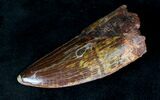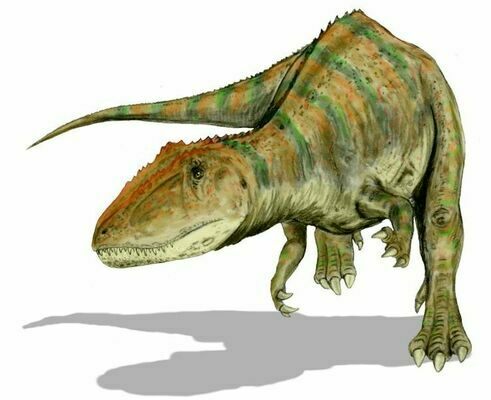This Specimen has been sold.
Very Robust 2.61" Carcharodontosaurus Tooth
This is a very thick and nicely preserved, 2.61" tooth of Carcharodontosaurus saharicus, one of the largest known meat-eating dinosaurs. Carcharodontosaurus often gets compared to T-Rex, but was actually thought to be bigger, and lived 30 million years earlier.
This tooth has wonderful enamel preservation, good serrations and just a bit of feeding wear to the tip. It's a very thick, robust tooth. There is some repair/restoration work near the base of the tooth where it was broken and there was a gap between the two pieces.
This tooth has wonderful enamel preservation, good serrations and just a bit of feeding wear to the tip. It's a very thick, robust tooth. There is some repair/restoration work near the base of the tooth where it was broken and there was a gap between the two pieces.
About Carcharodontosaurus
Carcharodontosaurus comprised a genus of dinosaurs that dominated the land during the mid-Cretaceous Period, between 100-93 million years ago. This genus currently includes two gigantic species, which were among the largest known predatory dinosaurs. They were immense as the genera Tyrannosaurus and Giganotosaurus, but not as colossal as Spinosaurus.
Along with the spinosaurids, carcharodontosaurids were the largest predators in the early and middle Cretaceous throughout Gondwana, with species also present in North America (Acrocanthosaurus), and Asia (Shaochilong). Various scientists submit length estimates for C. saharicus, ranging between 12 and 13 m (39-43.5 ft) and weight estimates between 6 and 15 metric tons.
Carcharodontosaurids were a scourge of the land as giant, shark-toothed terrors in a world of monsters. Though spinosaurids would have been a formidable enemy, they may have occupied a semi-aquatic niche, which reduced competition. Both giant hunters also shared their world with menacing, 30-foot ancient crocodiles that had a taste for dinosaur.
Past the Turonian (93.9-89.8 mya), Carcharodontosaurus might have been replaced by the smaller abelisaurids in Gondwana and by tyrannosaurids in North America and Asia. The disappearance of carcharodontosaurids, spinosaurids, and other fauna in Gondwana and across the world suggests a global replacement event. Despite the event, fossils discovered in Brazil, which appear to be carcharodontosaurids, indicate some survivors of this group until the latest stage of the Cretaceous.
Carcharodontosaurus comprised a genus of dinosaurs that dominated the land during the mid-Cretaceous Period, between 100-93 million years ago. This genus currently includes two gigantic species, which were among the largest known predatory dinosaurs. They were immense as the genera Tyrannosaurus and Giganotosaurus, but not as colossal as Spinosaurus.
Along with the spinosaurids, carcharodontosaurids were the largest predators in the early and middle Cretaceous throughout Gondwana, with species also present in North America (Acrocanthosaurus), and Asia (Shaochilong). Various scientists submit length estimates for C. saharicus, ranging between 12 and 13 m (39-43.5 ft) and weight estimates between 6 and 15 metric tons.
Carcharodontosaurids were a scourge of the land as giant, shark-toothed terrors in a world of monsters. Though spinosaurids would have been a formidable enemy, they may have occupied a semi-aquatic niche, which reduced competition. Both giant hunters also shared their world with menacing, 30-foot ancient crocodiles that had a taste for dinosaur.
Past the Turonian (93.9-89.8 mya), Carcharodontosaurus might have been replaced by the smaller abelisaurids in Gondwana and by tyrannosaurids in North America and Asia. The disappearance of carcharodontosaurids, spinosaurids, and other fauna in Gondwana and across the world suggests a global replacement event. Despite the event, fossils discovered in Brazil, which appear to be carcharodontosaurids, indicate some survivors of this group until the latest stage of the Cretaceous.
SPECIES
Carcharodontosaurus saharicus
LOCATION
Taouz, Kem Kem Basin, Morocco
FORMATION
Kem Kem Beds
SIZE
2.61" long (straightline)
CATEGORY
SUB CATEGORY
ITEM
#19267
We guarantee the authenticity of all of our specimens.
 Reviews
Reviews

















